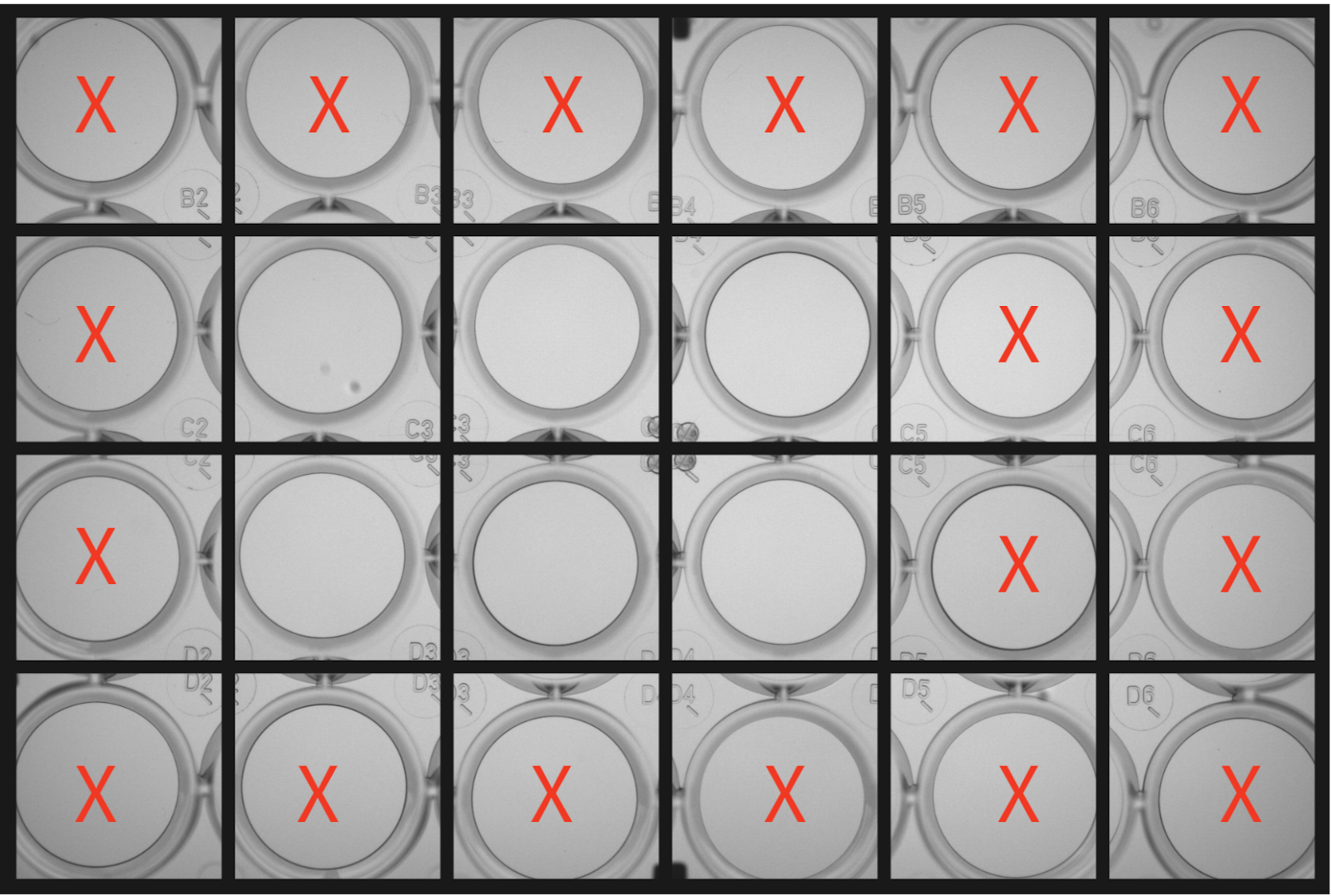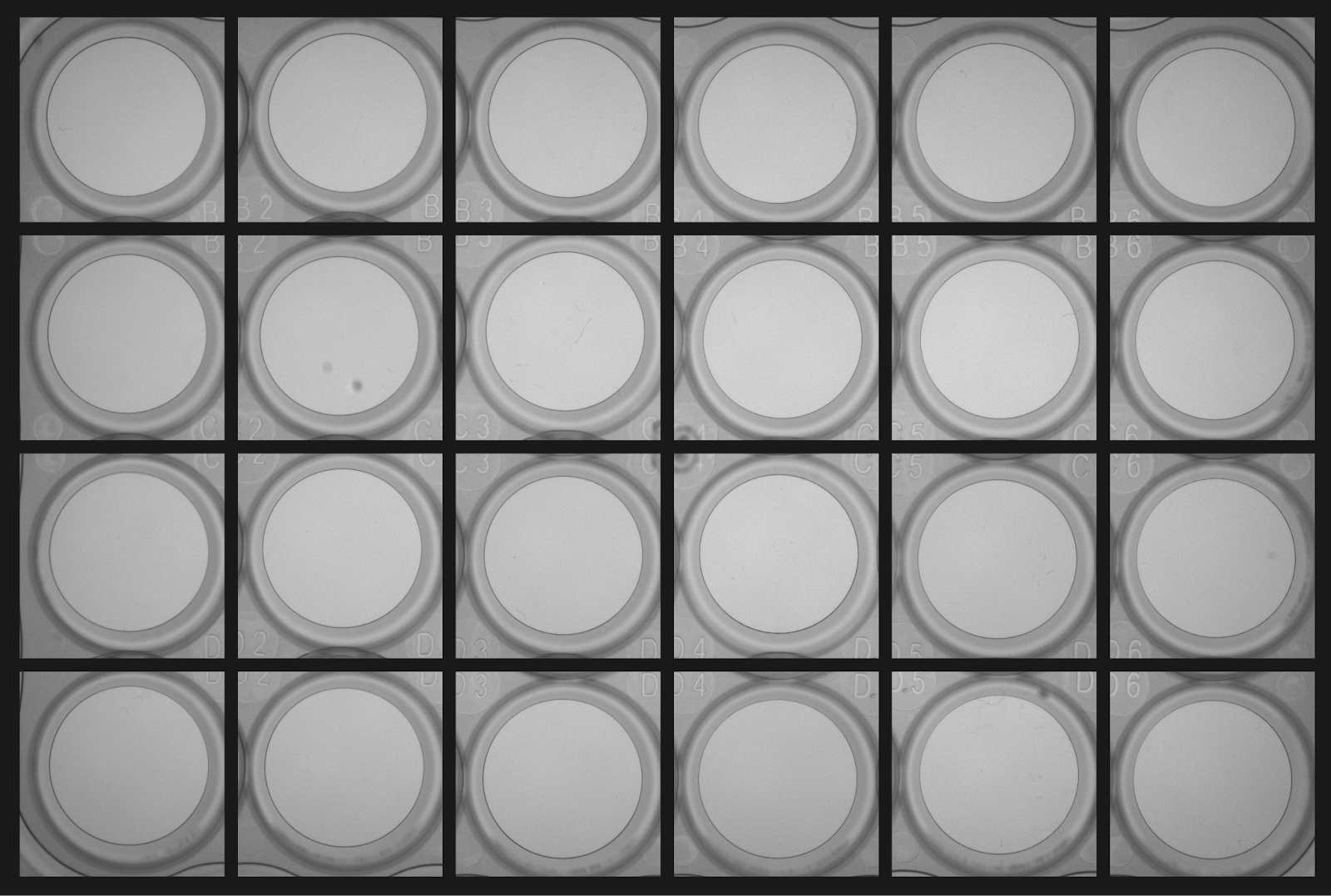Choosing the Right Well Plate for Your Kestrel: Why Plate Compatibility Matters
.png)

Introduction
The Kestrel is a multi-camera array microscope designed for a larger field of view with a higher-resolution, high-throughput imaging of entire well plates. Unlike conventional systems that rely on a single camera to capture an entire plate, forcing researchers to sacrifice resolution for coverage, the Kestrel takes a different approach. Each camera in the array images a smaller region of the plate, enabling whole-plate capture at both higher resolution and higher frame rates.
For example, when imaging zebrafish behavior, a traditional single-camera setup might record all 24 wells at once but with limited spatial detail. With the Kestrel, each well in a 24-well plate is imaged by its own dedicated camera, and for 96-well plates, each camera captures four wells at a time. This design allows researchers to achieve precise, high-speed imaging across multiple samples simultaneously without compromising quality.

The key consideration is the well plate type. Because each camera in the Kestrel array is optically aligned to a specific spacing, the system was designed around a single well plate standard: an 18mm pitch or well spacing. Using plates with different geometries, such as 19mm pitch, can introduce alignment mismatches that lead to cropping of wells in the captured images.
In this post, we’ll explain why well plate compatibility matters, how the Kestrel’s design makes it uniquely powerful (and sensitive to plate geometry), and how you can ensure your imaging setup delivers optimal results.
Why Plate Compatibility Matters
Alignment between cameras and wells
At Ramona,we’ve optimized the Kestrel around a camera pitch of 18 mm, allowing each camera to capture an entire well. According to the Society for Biomolecular Screening (SBS), the standard pitch for a 96-well plate is 9 mm, and by designing the Kestrel with an 18 mm pitch, we can effectively image any well plate that follows the SBS recommendations for well plate dimensions. Because the camera spacing is fixed at 18 mm, the wells of the plate must also match this spacing to ensure proper alignment and prevent cropping in the captured images.
Field of View/Sensor Size Tradeoffs
You want the tightest field of view (FOV) or sensor size that includes all wells, without extra unused regions. But if your plate geometry doesn’t align with the hardware, you’re forced into either cropping (losing part of the plate) or overshooting (capturing unnecessary pixels, which costs on throughput, frame rate, and storage).



Overview of Performance Trade-offs:
- Frame rate: the more of the sensor you use (larger FOV), the more data each frame contains, which reduces the maximum speed in frames per second (fps) the system can achieve.
- Storage: extra pixels = more data to store, transfer, and process.
What We Support (Today):The Watson 24-Well Plate
- Our systems are aligned and optimized for Watson 24-well plates, which follow the SBS-recommended 18 mm well pitch.
- When using Watson plates, customers can reliably use preset sensor sizes like 2048 × 2048 to collect zebrafish behavior data at a frame rate of 160 fps without clipping wells.
- For non-Watson plates (specifically well plate brands with a pitch larger than 18mm), customers must use the larger preset sensor size of 3072 × 3072, though it may significantly reduce fps.
Due to the design constraints, we recommend that most users working in high-throughput, high-fps regimes adopt 18mm pitch plates in their workflows for best performance.
Because of this, we distribute Watson 24-well plates through Ramona, enabling users to test them in their own systems and confirm performance gains.
If you must use non-Watson plates, we recommend using the preset sensor size of 3072x3072. This setting allows you to capture the full well, however, it will slow down acquisition by reducing the maximum frame rate and increase the total amount of data generated. While the slower acquisition rate is a limitation of the system’s architecture, we’ve implemented a solution to help manage the larger data load. By using the well plate alignment feature, the system can automatically crop individual wells from the full image, which reduces overall file size and helps streamline downstream analysis.
If you wish to purchase well plates, please contact sales@ramonaoptics.com
.png)
Choosing the Right Well Plate for Your Kestrel: Why Plate Compatibility Matters
Introduction
The Kestrel is a multi-camera array microscope designed for a larger field of view with a higher-resolution, high-throughput imaging of entire well plates. Unlike conventional systems that rely on a single camera to capture an entire plate, forcing researchers to sacrifice resolution for coverage, the Kestrel takes a different approach. Each camera in the array images a smaller region of the plate, enabling whole-plate capture at both higher resolution and higher frame rates.
For example, when imaging zebrafish behavior, a traditional single-camera setup might record all 24 wells at once but with limited spatial detail. With the Kestrel, each well in a 24-well plate is imaged by its own dedicated camera, and for 96-well plates, each camera captures four wells at a time. This design allows researchers to achieve precise, high-speed imaging across multiple samples simultaneously without compromising quality.

The key consideration is the well plate type. Because each camera in the Kestrel array is optically aligned to a specific spacing, the system was designed around a single well plate standard: an 18mm pitch or well spacing. Using plates with different geometries, such as 19mm pitch, can introduce alignment mismatches that lead to cropping of wells in the captured images.
In this post, we’ll explain why well plate compatibility matters, how the Kestrel’s design makes it uniquely powerful (and sensitive to plate geometry), and how you can ensure your imaging setup delivers optimal results.
Why Plate Compatibility Matters
Alignment between cameras and wells
At Ramona,we’ve optimized the Kestrel around a camera pitch of 18 mm, allowing each camera to capture an entire well. According to the Society for Biomolecular Screening (SBS), the standard pitch for a 96-well plate is 9 mm, and by designing the Kestrel with an 18 mm pitch, we can effectively image any well plate that follows the SBS recommendations for well plate dimensions. Because the camera spacing is fixed at 18 mm, the wells of the plate must also match this spacing to ensure proper alignment and prevent cropping in the captured images.
Field of View/Sensor Size Tradeoffs
You want the tightest field of view (FOV) or sensor size that includes all wells, without extra unused regions. But if your plate geometry doesn’t align with the hardware, you’re forced into either cropping (losing part of the plate) or overshooting (capturing unnecessary pixels, which costs on throughput, frame rate, and storage).



Overview of Performance Trade-offs:
- Frame rate: the more of the sensor you use (larger FOV), the more data each frame contains, which reduces the maximum speed in frames per second (fps) the system can achieve.
- Storage: extra pixels = more data to store, transfer, and process.
What We Support (Today):The Watson 24-Well Plate
- Our systems are aligned and optimized for Watson 24-well plates, which follow the SBS-recommended 18 mm well pitch.
- When using Watson plates, customers can reliably use preset sensor sizes like 2048 × 2048 to collect zebrafish behavior data at a frame rate of 160 fps without clipping wells.
- For non-Watson plates (specifically well plate brands with a pitch larger than 18mm), customers must use the larger preset sensor size of 3072 × 3072, though it may significantly reduce fps.
Due to the design constraints, we recommend that most users working in high-throughput, high-fps regimes adopt 18mm pitch plates in their workflows for best performance.
Because of this, we distribute Watson 24-well plates through Ramona, enabling users to test them in their own systems and confirm performance gains.
If you must use non-Watson plates, we recommend using the preset sensor size of 3072x3072. This setting allows you to capture the full well, however, it will slow down acquisition by reducing the maximum frame rate and increase the total amount of data generated. While the slower acquisition rate is a limitation of the system’s architecture, we’ve implemented a solution to help manage the larger data load. By using the well plate alignment feature, the system can automatically crop individual wells from the full image, which reduces overall file size and helps streamline downstream analysis.
If you wish to purchase well plates, please contact sales@ramonaoptics.com
.webp)
